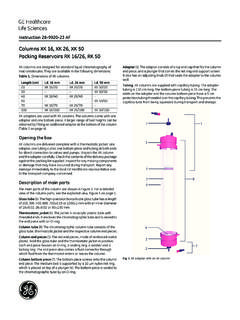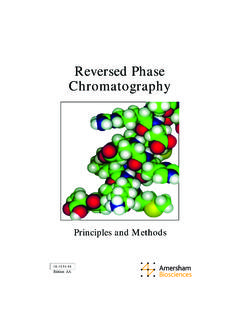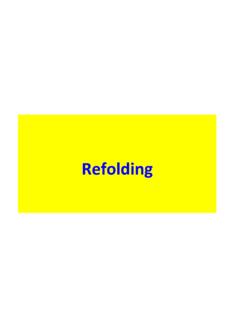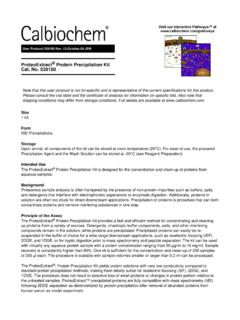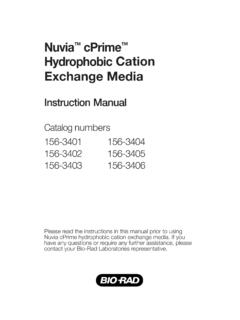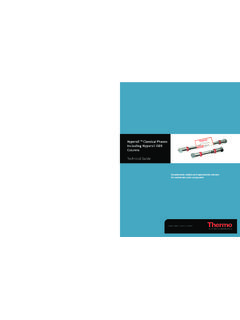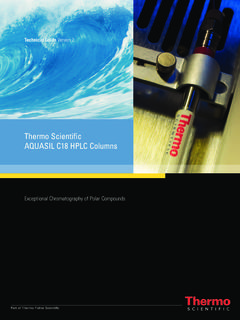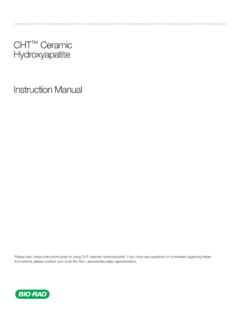Transcription of Ion exchange columns and media - Wolfson Centre Home Page
1 GE Healthcare Ion exchange columns and media Selection Guide imagination at work General information Principle of Ion exchange equilibration sample injection gradient elution wash re-equilibration Chromatography volume high salt wash 1M. 5 CV. Ion exchange (IEX) chromatography can separate molecules tightly bound molecules or groups of molecules that have only slight differences in unbound molecules elute elute in high salt wash charge. Separation is based on the reversible interaction before gradient begins between a charged molecule and an oppositely charged [NaCl].
2 Chromatography medium. Typically, conditions are selected to ensure that the molecules of interest bind to the medium 10 20 CV. as they are loaded onto the column. Conditions are then 5 10 CV. 5 10 CV. altered so that the bound substances are eluted differentially. 0. Column volumes [CV]. Elution is most often performed by a continuous gradient Fig 1. Typical IEX separation using gradient elution. or a stepwise increase in ionic strength, most commonly using NaCl. Figure 1 shows a typical high resolution gradient elution. A stepwise elution is illustrated in Figure 3.
3 Selectivity and buffer pH. Proteins are built up of many different amino acids containing Figure 2 shows the effect of pH on selectivity. The separation weak acidic and basic groups ( ionizable groups) that of three hypothetical proteins at different pH is described can be titrated. Hence, the net surface charge of a protein below, and the four scenarios are illustrated in the figure is highly pH dependent and will change gradually as the (see numbered arrows). pH of the environment changes. Each protein has its own 1. Most acidic pH: all three proteins are below their unique net charge versus pH relationship which can be isoelectric point, positively charged, and bind only to a cation visualized as a titration curve (Figure 2).
4 This curve reflects exchanger. Proteins are eluted in the order of their net charge. how the overall net charge of the protein changes according 2. Less acidic pH: the blue protein is above its isoelectric to the pH of the surroundings. IEX can be repeated at point, negatively charged, and the other proteins are different pH values to separate several proteins which still positively charged. Blue protein binds to an anion have distinctly different charge properties. Figure 2 shows exchanger and can be separated from the other proteins how selecting the correct pH is one of the most important which wash through.
5 Alternatively, red and green proteins parameters in achieving satisfactory separation. can be separated on a cation exchanger and the blue protein washes through. Choice of ion exchanger Begin with a strong exchanger (Q, S, SP) to enable development 3. Most alkaline pH: all three proteins are above their work to be performed over a broad pH range. Use a strong isoelectric point, negatively charged, and bind only to the anion exchanger (Q) to bind the protein(s) of interest if their anion exchanger. Proteins are eluted in the order of their isoelectric point is below pH or unknown.
6 Net charge. Use a strong exchanger in those cases where maximum 4. Less alkaline pH: the red protein is below its isoelectric resolution occurs at an extreme pH and the proteins of point, positively charged. Red protein binds to the cation interest are stable at that pH. exchanger, while the other proteins wash through. Alternatively, blue and green proteins can be separated on Consider using a weak exchanger (DEAE, ANX, CM) if the an anion exchanger and the red protein washes through. selectivity of the strong ion exchanger is unsatisfactory, but remember that the ion exchange capacity of a weak 1 3.
7 Ion exchanger varies with pH. Abs Abs Abs Abs Multimodal ligands (MMC, adhere) provide ionic interaction, hydrogen bonding and hydrophobic interaction. MMC behaves V V V V. like a weak cation exchanger, but allows binding at high conductivity. Adhere behaves as a strong anion exchanger. +. Cation Chromatography media selection Surface net charge Select the ion exchange medium according to the objective 0 pH. of the purification step and the condition of the starting Anion material. Other factors such as sample stability, scale, speed, binding capacity and equipment available may also.
8 Influence the final choice. Abs Abs Abs Abs V V V V. 2 4. Fig 2. Effect of pH on selectivity (elution patterns). Sample preparation Method development and Correct sample preparation is essential in order to achieve optimization (in priority order). optimal separation and avoid deterioration in column 1. Scout for optimum pH by testing a range of pH values performance. Samples must be clear and free from within which the proteins of interest are known to particulate matter. be stable. If the isoelectric point of the target protein To remove particulate matter, filter (see Buffer Preparation is known, then begin with a narrower pH range, for for filter sizes) or centrifuge (10 000 g for 15 min).
9 Example, 1 pH unit away from the isoelectric point. Desalt samples and transfer into the chosen start buffer 2. If required, scout for optimum selectivity (testing strong using HiTrap Desalting 5 ml (volumes up to ml) or or weak exchangers) using automatic media scouting. HiPrep 26/10 Desalting (volumes up to 15 ml). 3. Scout for the steepest gradient that gives acceptable Very small sample volumes in high salt concentration, with resolution at the selected pH. no major contaminants, can be diluted with start buffer to lower the salt concentration to a level that does not 4.
10 Scout for the highest flow rate that maintains resolution interfere with binding to the medium. and minimizes separation time. Check recommended flow rates for the specific medium. Column preparation 5. Scout for the maximum sample load that can be applied Wash away storage solutions and preservatives before while maintaining satisfactory resolution. In general, using any IEX medium. loading 20 30% of the total binding capacity of the Use prepacked columns to ensure the best performance column gives optimal resolution with gradient elution.



